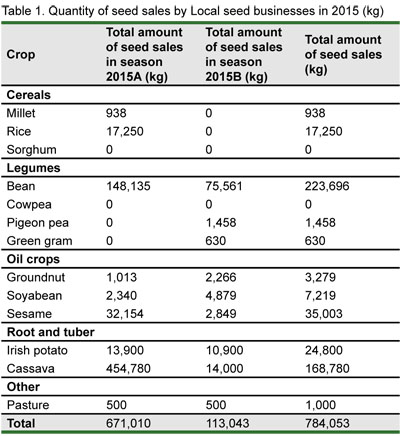In the first phase of N2Africa, activities were aimed at facilitating learning within the project through feedback loops. Experiences from dissemination activities were to be monitored and assessed and findings fed back into research as well as planning for next season dissemination activities. Findings from research were also fed back into dissemination efforts of N2Africa. For the second phase of the project, enabling continuous learning both within N2Africa, between related projects and with stakeholders outside the project has been outlined as characteristic (amongst others). Furthermore, sustainability of input supply and market systems have been defined as an important learning area (see N2Africa Monitoring & Evaluation and Data Management Master Plan).
The Integrated Seed Sector Development project (ISSD) in Uganda is one, out of many, related projects from which we can learn. ISSD aims to strengthen different seed systems in a country and to support the development of a vibrant, market-oriented seed sector. This article describes issues of poor quality seed in the Ugandan market.
What is the Ugandan private sector doing?
One way in which agricultural productivity can be increased, without significantly increasing land under production, is by planting quality seed. A baseline study done in 2013 by ISSD Uganda indicates that only 11% of the farmers obtain seed from formal sources. The remaining 89% of the farmers obtain seed from informal sources, including own saved seed, local market and neighbours. As seed is a key input to production, supporting the informal seed sector is one way through which development actors can increase agricultural productivity in Uganda (see link Supporting local seed businesses: a training manual for ISSD Uganda).
The Integrated Seed Sector Development project in Uganda has been working since 2013 to bridge the 89% gap in quality seed use by farmers in the rural areas by supporting informal seed production. Since its inception, the project has been working with 30 farmer groups in the south western, northern and West Nile zones of Uganda. The farmer groups have been groomed to become well established entities referred to as ‘Local Seed Businesses’ (LSBs); their product for the seed market being Quality Declared Seed (QDS). The ISSD project is implemented through the Zonal Agricultural Research and Development Institutes (ZARDIs) of NARO in the three zones mentioned.
What is Quality Declared Seed and how is it going to make a difference to a rural farmer?
QDS is a class of seed produced by local seed businesses (LSBs) that have been coached by ISSD to do technical seed production, to be market oriented, professionally organized and linked to the relevant service providers. The seed grown by these farmer groups is under the QDS-class and it is not marketed by seed companies. Therefore, seed of crops such as maize, rice and sunflower are excluded for LSB marketing. The LSB farmers produce and market seed of cereals (such as barley, wheat, millet and sorghum), legumes, oil crops, root and tubers, amongst others (Table 1). Seed production of these QDS crops is considered unprofitable by seed companies, but the crops remain essential in rural communities mainly for food security reasons. As a requirement, QDS produced within a specific region can only be sold by the LSB within the boundaries of that region. In spite of this seed class being produced by farmers, its quality is assured throughout production by quality checks. These checks include external field inspections, seed testing and tamperproof labeling. As compared to quality assurance for certified seed, the quality checks of QDS have been tailor made to suite a local seed grower while still maintaining the minimum standards of the seed.
|
Looking at the impact the QDS system as a seed source for rural farmers, the project has noted the following over the three years:
|
 |
The QDS system as a business opportunity to farmers
It has already been highlighted that the QDS system covers crops that are economically not interesting to seed companies. This raises the question why farmers groups would take up such a venture.
The LSB farmers engaged in QDS production are actually doing this for the same reasons as why seed companies produce seed for crops such as maize. It is about ‘financial gain’. The farmer groups are able to produce seed of QDS crops, because they have a comparative advantage over seed companies. With support from the ISSD project, the LSBs have been coached to study their local markets and make decisions on crop varieties and quantities desired by local grain producers. Since taking on the QDS business, these groups have seen themselves earning incomes that have made significant contributions to their households.
| We consider a very simple approach to see how LSB farmers make more money from seed production vis-a-vis grain production by focusing on price differences. Table 2 shows the average prices of seed and grain for soyabean, bean and groundnut grown in northern Uganda. |  |
Table 2 shows that a soyabean seed farmer, for example, has an opportunity to make more than twice as much profit as a soyabean grain farmer. This extra income has improved their livelihoods.
What happens with the QDS system when the ISSD project withdraws from the communities?
With the growing success in LSB activities over the year, there was need for ISSD to create a system that will sustain QDS production even after the project is withdrawn from the zones. One of the strategies employed was the engagement of partner organizations that have working objectives related to supporting farmers in processes that lead to sustainable seed availability. ISSD therefore partnered with 14 organizations to out scale the LSB approach in their areas of operation. This was for the purpose of increasing the geographic outreach, engaging in more crops and varieties, as well as involving different types of farmer groups.
Astrid Mastenbroek and Kawuma Christine Menya, ISSD Uganda
